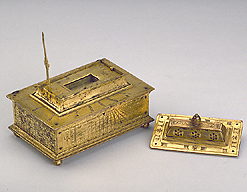
 |
| Catalogue |
 |
 Horizontal Dial The main part of the box stands on four bun feet, and is at present empty but has inside rails for drawers. The sides of the box are engraved with dials and tables. On the north side is a table inscribed 'Tabula Planetarii', 'Hora<e> diei', 'Hora<e> noctis'. It is inscribed with the symbols of the five planets, sun and moon, twice on the horizontal line, and with their names on the vertical line. The east side of the box has a table, inscribed 'maius et minus Horologium Oppositum et ad aequatium', for converting common hours into Italian hours, according to the time of sunset. This is indicated on the left hand side by 'Occasus', divided to the half hour, subdivided to the quarter hour, numbered from 3 to 9 by one. The scale indicates common hours as vertical line, divided to the half hour and subdivided to the quarter hour, numbered from 3 to 12 to 9 by one. Italian hours are indicated as diagonal lines, numbered from 7 to 24. The spaces outside the table are indicated 'Ante Meridi<em>' and 'Post meridi<em>'. The south side of the box has a table of multiplication of the numbers from 1 to 10. Below is a compartment now empty, probably for a sliding drawer. The west side of the box has again a table for converting hours, indicated 'Horae diurne cum Vulgares tum Planetar<ii> inter se adaequatum'. Again the time of sunset is indicated in the left side 'Occasus', with hours divided to the half hour, subdivided to the quarter hour and numbered from 3 to 9 by one. Common hours are indicated as vertical lines, divided to the half hour and subdivided to the quarter hour, numbered from 3 to 12 to 9 by one. Unequal hours, or planetary hours, are indicated as diagonal lines, numbered from 1 to 12. They are also indicated 'Ante Meridi<em>' and Post meridi<em>'. The top of the main part of the box is engraved with the initials of the main 16 directions in Dutch. At the centre of the lid plate is a compartment, with linear decoration on the sides, with a compass in the centre. Magnetic deviation and the four cardinal points are indicated in Latin. On the borders are hour lines for a string gnomon dial, from 3 to 12 to 9, divided to the half hour and subdivided to the quarter hour. The string (now missing) was kept in place by a folding decorated support. On the dial plate are two small holes, presumably for adjusting the latitude, wrongly placed on the plate instead of the support. They are indicated 49 and 51, with the number 50 engraved between them. A monogram is engraved below the small holes. The inner part of the lid is engraved with a 'CALENDARIVM PERPETVVM' in the central part, indicating some saint's and holy days' dates. From the top (January), they are 'Circu<mci>s<io>', 'Epiph<aniae>', 'Fab Seb', 'Agnel', 'ConSP' in January, 'Brigit', 'PurBV', 'Doroth', 'Schola', 'Math' in February, 'Tho<mas> Aq', 'Gregor.', 'Gertru', 'Bened', 'AnBV' in March, 'Ambros', 'Valeri', 'Tiburt', 'Georg.', 'Marc<us>' in April, 'Phi. Jac', 'In S [cross]', 'Ap.S.Mi', 'Helen', 'Vrban', in May, 'Meda<rdus>', 'Vitus', 'S Joa<nnis>B', 'Ladis<laus>', 'S Pe<trus> Pa<pis>'in June, 'Vis BV', Marg<herita>', 'M: Mag', 'S Jacob', 'S Anna' in July, 'Pel[?] Adu[?]', 'M adm', 'S Lau<rentii>', 'Ass BV', 'S Bart' in August, 'Egidi<i>', 'Na<tivitas> BV', 'Ex S [cross]', 'Math<iae?>', 'S Midi' in September, 'Franc<iscii>', 'Burch', 'Lucas', 'Vrsula', 'Sim Ju[?]' in October, 'Om{nis} Sa<nctis>', 'Martin', 'Pra<esentatio?> BV', 'Cathar{inae}', 'Andre{ae}' in November, 'Barba{rae}', 'Nicol<ae>', 'Con BV', 'Thom', 'Nat Chi' in December. On both sides of the calendar the length of the lid is divided into180 degrees, subdivided to five, with further divisions to one, with the letters 'D' at the top and 'M' at the bottom, then two brass bands with the number of days of each month. On the lid plate, external to the bands, is the same division as on the internal part, but without the smaller divisions to the degree. At the top is the letter 'G', only on the right hand side, and at the bottom, on both sides, the letter 'M'. Symbols for the zodiacal signs are engraved on the external sides of the scales. On the left hand side is a scale marked 'Ortus' and 'Occas{us}', with four columns indicating the times of sunrise and sunset, with the letters 'H{orae} ? M{inutis} ? H ? M' at the bottom. On the far right hand side is another table with the length of the day and of the night, with the same indication of hours and minutes. The lid for this compartment has a geometrical decoration and a third compartment, pierced on the sides, which can be opened from the inside of the lid. A finial on decorated plate surmounts the second lid. The instrument was presented by A.W. Franks in 1871 and is described in F. A. B. Ward, A Catalogue of European Scientific Instruments in the Department of Medieval and Later Antiquities of the British Museum (London, 1981), p. 23, no.15. Ilaria Meliconi |



